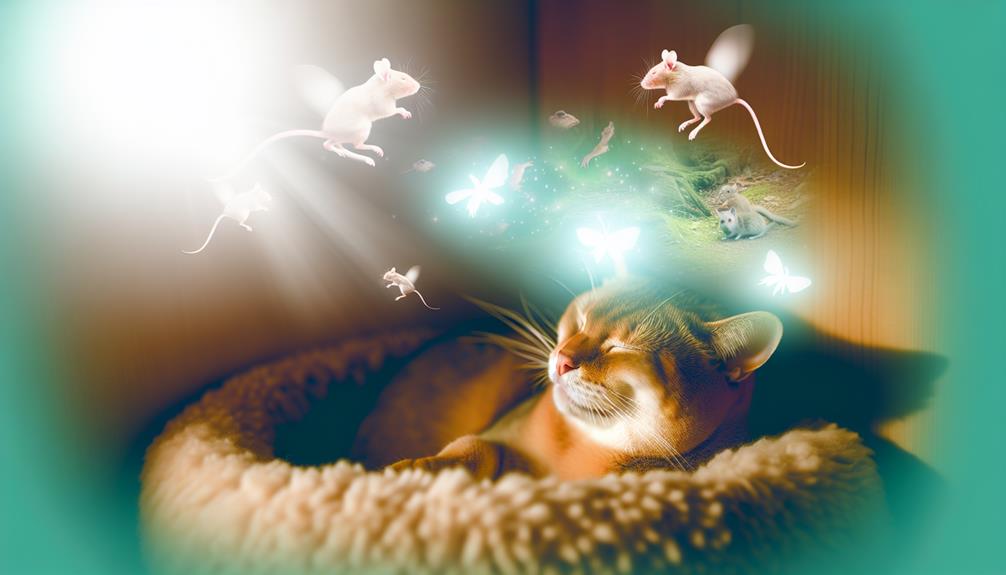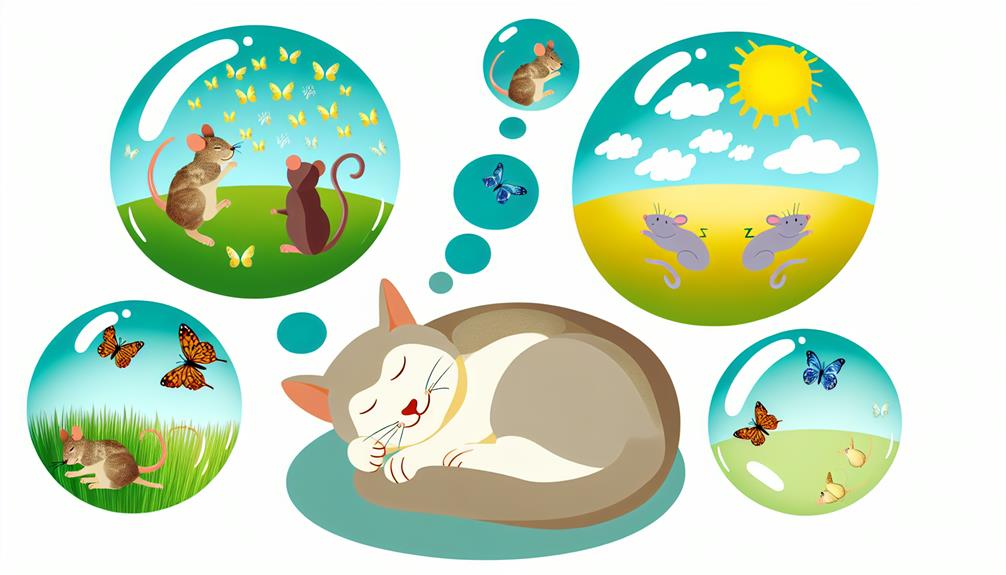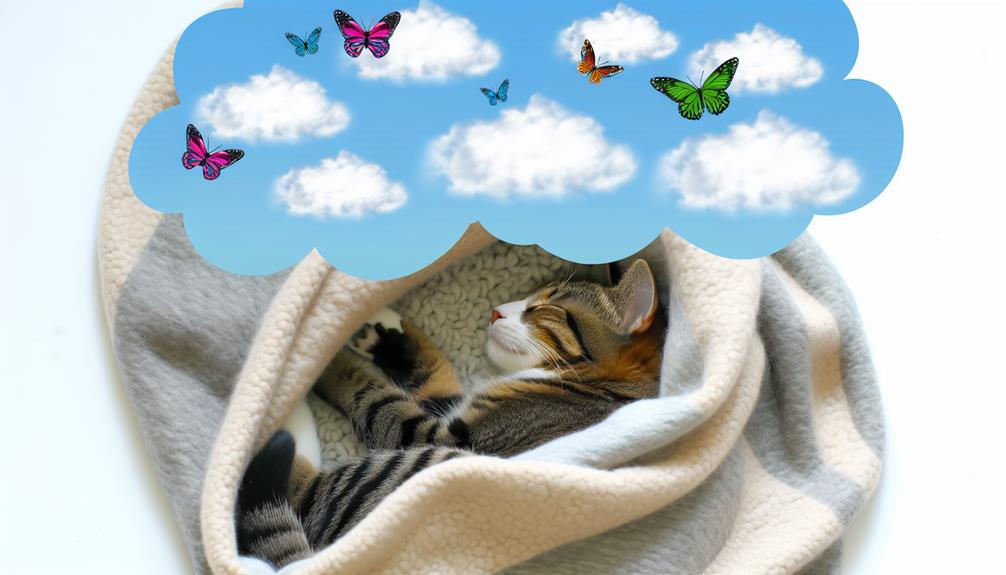Have you ever watched your cat twitching or making little noises while they sleep and wondered if they're dreaming? Scientific studies show that cats' brain activity during REM sleep closely mirrors that of humans, suggesting they experience dreams too. You might be curious about what these feline dreams entail and how they reflect your cat's daily life and instincts. Understanding your cat's dreaming habits could offer fascinating insights into their emotional world. So, what's really going on in your slumbering feline's mind? Let's explore further to uncover the mysteries of their dream-filled sleep.
Stages of Feline Sleep
Feline sleep is categorized into two main stages: rapid eye movement (REM) sleep and non-rapid eye movement (NREM) sleep. Your cat's sleep cycles involve alternating between these two stages, each playing a distinct role in their overall rest and well-being.
During NREM sleep, which constitutes the bulk of a cat's slumber, physiological repair and growth occur. This stage includes both light and deep sleep phases. In light NREM sleep, cats are easily aroused and may appear to be taking "cat naps." These short bursts of rest allow your cat to stay vigilant to potential threats while still getting some restorative sleep. Deep NREM sleep, on the other hand, is essential for physical restoration and immune system function. Your cat's body temperature drops, heart rate slows, and muscle tone decreases during this phase.
Cats undergo multiple sleep cycles throughout their rest period, with each cycle lasting approximately 20-30 minutes. These sleep cycles include both NREM and REM stages, allowing for a balanced distribution of restorative and cognitive functions. The frequency of sleep cycles explains why cats often appear to be in a state of semi-alertness even while sleeping.
Understanding these stages is important for appreciating the complexity of feline sleep patterns. By recognizing the significance of both NREM and REM stages in their sleep cycles, you're better equipped to guarantee an environment conducive to your cat's health and well-being. Providing a quiet, safe space for your cat to nap and cycle through these stages is crucial for their physical and mental health.
Understanding REM Sleep
When examining cats' REM sleep patterns, you'll notice that this phase is characterized by rapid eye movements and increased brain activity. During REM sleep, a cat's brain exhibits patterns similar to those observed in wakefulness, suggesting a high level of neural activity. This stage is essential for cognitive functions and may be when dreaming occurs.
Cats' REM Sleep Patterns
In the domain of sleep science, understanding REM (Rapid Eye Movement) sleep in cats provides a window into their complex neurological processes. REM sleep is a distinct sleep stage characterized by rapid eye movements, increased brain activity, and temporary muscle atonia. Cats, like humans, undergo sleep cycles that alternate between non-REM (NREM) and REM sleep. Typically, a cat's sleep cycle is shorter, lasting around 20-30 minutes, with the REM phase constituting a smaller portion compared to humans.
Feline behavior during REM sleep includes twitching of the whiskers, paws, and tail, which indicates muscle atonia interspersed with brief, sporadic movements. These behavioral manifestations suggest that cats are likely experiencing dream-like states. Research indicates that kittens spend more time in REM sleep than adult cats, which is believed to be vital for neurological development. The high frequency of REM sleep in young cats supports the hypothesis that REM sleep plays an important role in brain maturation and overall cognitive function.
Understanding these sleep patterns provides insight into your cat's behavioral health and neurological well-being. Monitoring your cat's sleep cycles and recognizing the significance of REM sleep can help you guarantee they are getting the rest they need for peak health.
Brain Activity During REM
Understanding cats' REM sleep patterns naturally leads to exploring the underlying brain activity during this stage. During REM sleep, a cat's brain exhibits heightened activity, akin to wakefulness. This stage is marked by rapid eye movement, irregular breathing, and increased brainwave frequency. The brain's neural connections are particularly active during REM, suggesting a crucial period for synaptic plasticity, which is essential for learning and memory consolidation.
Studies using electroencephalography (EEG) have shown that during REM sleep, cats experience bursts of electrical activity in the pons, a brainstem region. This activity is transmitted to the thalamus and subsequently to the cerebral cortex, the area responsible for higher-order brain functions. These bursts, or PGO waves (pontine-geniculate-occipital), are believed to facilitate the processing of information and the integration of experiences encountered during wakefulness.
The cyclical nature of sleep cycles in cats, alternating between non-REM and REM stages, indicates a complex interplay between various brain regions. REM sleep, making up about 20-25% of their total sleep, is crucial for maintaining cognitive functions and overall brain health. By understanding these neural mechanisms, you gain insight into the sophisticated nature of feline sleep and its potential implications for their waking behaviors.
Evidence of Cat Dreams

To understand if cats dream, you'll need to look at brain activity patterns during sleep. Cats exhibit REM sleep indicators similar to humans, including rapid eye movement and shifts in brain waves. Behavioral observations, such as twitching and vocalizations, further support the presence of dream-like states in felines.
Brain Activity Patterns
Numerous studies have demonstrated that cats exhibit distinct brain activity patterns during sleep, strongly suggesting they experience dreams. By examining feline neural connections through electroencephalography (EEG), researchers have identified specific sleep cycles analogous to those found in humans. These cycles include periods of slow-wave sleep (SWS) and more active phases, indicative of complex brain functioning.
During these sleep cycles, cats' brains show significant electrical activity. In SWS, neural connections exhibit synchronized firing patterns, which are vital for memory consolidation. This phase is essential for processing daily experiences and is associated with what many scientists believe to be the foundational elements of dreaming. When cats shift from SWS to more active sleep stages, the brain's electrical activity becomes desynchronized, resembling patterns seen in awake states.
The presence of these distinct brain activity patterns aligns with the hypothesis that cats engage in dream-like experiences. Such evidence underscores the functional similarities between feline and human sleep architecture, suggesting a shared evolutionary advantage in processing and integrating sensory information through dreams. This clinical perspective on feline brain activity provides a compelling foundation for the existence of dreams in cats, grounded in observable and measurable neural phenomena.
REM Sleep Indicators
Building on the understanding of feline brain activity patterns during sleep, another significant indicator of cat dreams lies within the domain of REM sleep. REM, or Rapid Eye Movement, sleep is a distinct phase of the sleep cycle characterized by low-amplitude, mixed-frequency brain waves, similar to those observed during wakefulness. In cats, as in humans, REM sleep is strongly associated with dreaming.
Research has shown that during this phase, a cat's brain activity spikes, mirroring the patterns seen during periods of wakeful alertness. These neural oscillations suggest that the brain is processing information, likely forming the basis for dreams. The frequency of these REM episodes within a sleep cycle further supports the hypothesis that cats experience dreams. Typically, cats enter REM sleep multiple times during each sleep cycle, with dream frequency increasing during longer sleep periods.
Clinical studies, utilizing electroencephalography (EEG), have revealed that approximately 60% of a cat's sleep is spent in light sleep, 30% in deep sleep, and 10% in REM sleep. This distribution indicates that while REM phases are brief, they are recurrent and integral, providing robust evidence for the occurrence of dreams within the feline brain.
Behavioral Observations
While examining the behavioral manifestations of cat dreams, one can observe several compelling indicators during their sleep cycles. In particular, you'll notice that cats often exhibit muscle twitches, limb movements, and vocalizations. These behaviors are more prominent during the Rapid Eye Movement (REM) sleep phase, which closely parallels human dreaming patterns.
In clinical studies, playful interactions during wakefulness have been found to influence the content of feline dreams. For instance, a cat engaged in frequent play with toys or other animals is more likely to display paw movements and tail flicks during sleep, suggesting a replay of those activities. Observing these movements in varied sleep environments—ranging from quiet, secluded areas to more bustling spaces—can offer additional insights into how external stimuli might impact dream content.
Furthermore, subtle changes in a cat's facial expressions, such as whisker twitches or ear movements, are also indicative of dream states. These micro-expressions reflect the neural activity occurring in the brain's pons region, which is responsible for inhibiting major muscle groups while allowing minor motor activities. Consequently, by analyzing these behavioral cues, you can gather evidence supporting the hypothesis that cats do indeed dream, potentially mirroring their daily experiences.
Common Dream Behaviors
The intriguing domain of feline dream behaviors offers a window into the subconscious activities of our domestic companions. Research indicates that cats display several distinct dreaming behaviors during the Rapid Eye Movement (REM) stage of their sleep patterns. This stage is characterized by rapid eye movements, muscle atonia, and a higher likelihood of vivid dreams. Observational data have revealed that during REM sleep, cats often exhibit twitching of their paws, whiskers, and facial muscles, suggesting neurological activity linked to dreaming.
You might notice your cat's body quivering or its ears flicking sporadically. These involuntary movements are clinically significant, indicating muscle twitches that relate to the dream state. During polysomnographic studies, cats have demonstrated increased brain activity during REM sleep, mirroring the patterns seen in dreaming humans. Such evidence supports the hypothesis that these physical manifestations are correlated with complex neural processes involving memory consolidation and sensory processing.
Another common behavior includes vocalizations such as soft mews or purrs. These auditory signals might appear in tandem with the aforementioned twitches. From a clinical perspective, these vocalizations can be interpreted as responses to dream stimuli, similar to how humans might talk or cry out during a dream.
Additionally, some cats exhibit more pronounced behaviors like paddling their legs or even mimicking hunting actions. These behaviors are thought to reflect instinctual activities embedded within their neural architecture. Monitoring these dreaming behaviors provides valuable insights into the physiological and psychological well-being of your cat, offering a deeper understanding of their sleep patterns and overall health.
What Cats Might Dream About

Many researchers believe that cats' dreams may mirror their waking experiences, incorporating elements from their daily activities and instincts. Studies suggest that cats enter REM sleep, a phase associated with vivid dreams in humans. During this phase, your cat might engage in nocturnal adventures within their dreamscape, reenacting hunting scenarios or playful interactions.
In their dream world, cats may experience a variety of scenarios. For instance, your feline friend could be dreaming about stalking a mouse or bird, a reflection of their predatory instincts. These cat fantasies likely involve intricate details, from the rustle of leaves to the thrill of the chase, echoing their real-life behaviors.
Here's a table to illustrate potential dream scenarios and their emotional undertones:
| Dream Scenario | Emotional Undertone |
|---|---|
| Stalking prey | Excitement |
| Playing with toys | Joy and contentment |
| Exploring new territories | Curiosity and intrigue |
| Interacting with humans | Affection and trust |
Scientifically, these dream activities are linked to the neural activity observed during REM sleep. The activation-synthesis theory posits that dreams are the brain's attempt to make sense of random neural firings. Hence, your cat's brain might be replaying and processing daily experiences, transforming them into vivid dream sequences.
Moreover, older cats might dream more frequently about familiar routines, while younger cats could have more varied and adventurous dreams. These nocturnal adventures likely serve as a means for cognitive and emotional processing, aiding in their overall well-being.
In essence, your cat's dreams are a fascinating glimpse into their subconscious, reflecting a blend of instinctual behaviors and daily experiences. Understanding these dreams can foster a deeper connection and appreciation for your feline companion.
Enhancing Your Cat's Sleep
Understanding and enhancing your cat's sleep can greatly contribute to their overall health and well-being. Research indicates that cats, much like humans, require a conducive sleep environment and calming routines to achieve the best rest.
Firstly, focus on creating an ideal sleep environment. Cats are crepuscular animals, meaning they're most active during dawn and dusk. Consequently, their sleeping quarters should be situated in a quiet, dimly-lit area, minimizing disruptions from household activities. Utilize bedding materials that offer both comfort and warmth, such as soft blankets or cushioned beds, to mimic the cozy conditions cats instinctively seek out in the wild.
Secondly, establishing calming routines can markedly enhance your cat's sleep quality. Engage in interactive play sessions during their peak activity periods to help expend pent-up energy. Following playtime, a small, protein-rich meal can mimic the natural hunt-feed-rest cycle observed in feline behavior. This approach not only satisfies their predatory instincts but also promotes a state of relaxation conducive to sleep.
Moreover, incorporating environmental enrichment can aid in reducing stress-induced sleep disturbances. This includes providing scratching posts, climbing structures, and puzzle feeders, which can alleviate anxiety and promote mental stimulation.
Lastly, consider the role of routine veterinary check-ups. Regular health assessments can identify underlying issues such as pain or illness that may be disrupting your cat's sleep patterns. Addressing these concerns promptly promotes that your cat remains in the best health, further enhancing their ability to achieve restful sleep.
Conclusion
Just like how you might relive a cherished memory in your dreams, your cat could be hunting imaginary prey or exploring uncharted territories. Observing their twitching whiskers and paddling paws during REM sleep, it's clear they experience a rich dream life. Understanding this can enhance your bond, offering insights into their emotional worlds. So next time you see them dreaming, know they're as deeply immersed in their experiences as you are in yours.
